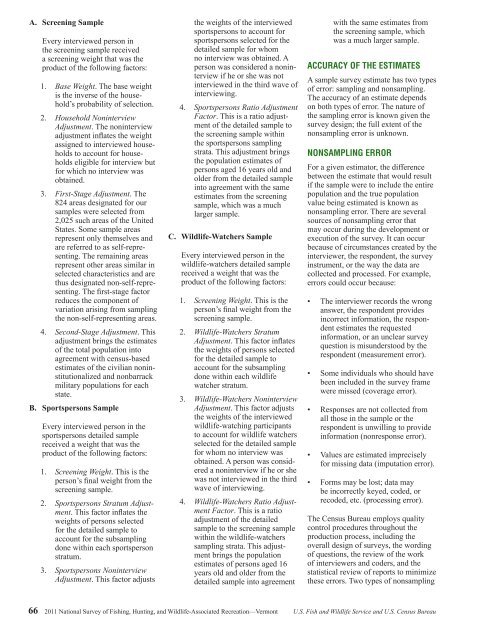2011 National Survey of Fishing, Hunting, and ... - Census Bureau
2011 National Survey of Fishing, Hunting, and ... - Census Bureau
2011 National Survey of Fishing, Hunting, and ... - Census Bureau
Create successful ePaper yourself
Turn your PDF publications into a flip-book with our unique Google optimized e-Paper software.
A. Screening Sample<br />
Every interviewed person in<br />
the screening sample received<br />
a screening weight that was the<br />
product <strong>of</strong> the following factors:<br />
1. Base Weight. The base weight<br />
is the inverse <strong>of</strong> the household’s<br />
probability <strong>of</strong> selection.<br />
2. Household Noninterview<br />
Adjustment. The noninterview<br />
adjustment inflates the weight<br />
assigned to interviewed households<br />
to account for households<br />
eligible for interview but<br />
for which no interview was<br />
obtained.<br />
3. First-Stage Adjustment. The<br />
824 areas designated for our<br />
samples were selected from<br />
2,025 such areas <strong>of</strong> the United<br />
States. Some sample areas<br />
represent only themselves <strong>and</strong><br />
are referred to as self-representing.<br />
The remaining areas<br />
represent other areas similar in<br />
selected characteristics <strong>and</strong> are<br />
thus designated non-self-representing.<br />
The first-stage factor<br />
reduces the component <strong>of</strong><br />
variation arising from sampling<br />
the non-self-representing areas.<br />
4. Second-Stage Adjustment. This<br />
adjustment brings the estimates<br />
<strong>of</strong> the total population into<br />
agreement with census-based<br />
estimates <strong>of</strong> the civilian noninstitutionalized<br />
<strong>and</strong> nonbarrack<br />
military populations for each<br />
state.<br />
B. Sportspersons Sample<br />
Every interviewed person in the<br />
sportspersons detailed sample<br />
received a weight that was the<br />
product <strong>of</strong> the following factors:<br />
1. Screening Weight. This is the<br />
person’s final weight from the<br />
screening sample.<br />
2. Sportspersons Stratum Adjustment.<br />
This factor inflates the<br />
weights <strong>of</strong> persons selected<br />
for the detailed sample to<br />
account for the subsampling<br />
done within each sportsperson<br />
stratum.<br />
3. Sportspersons Noninterview<br />
Adjustment. This factor adjusts<br />
the weights <strong>of</strong> the interviewed<br />
sportspersons to account for<br />
sportspersons selected for the<br />
detailed sample for whom<br />
no interview was obtained. A<br />
person was considered a noninterview<br />
if he or she was not<br />
interviewed in the third wave <strong>of</strong><br />
interviewing.<br />
4. Sportspersons Ratio Adjustment<br />
Factor. This is a ratio adjustment<br />
<strong>of</strong> the detailed sample to<br />
the screening sample within<br />
the sportspersons sampling<br />
strata. This adjustment brings<br />
the population estimates <strong>of</strong><br />
persons aged 16 years old <strong>and</strong><br />
older from the detailed sample<br />
into agreement with the same<br />
estimates from the screening<br />
sample, which was a much<br />
larger sample.<br />
C. Wildlife-Watchers Sample<br />
Every interviewed person in the<br />
wildlife-watchers detailed sample<br />
received a weight that was the<br />
product <strong>of</strong> the following factors:<br />
1. Screening Weight. This is the<br />
person’s final weight from the<br />
screening sample.<br />
2. Wildlife-Watchers Stratum<br />
Adjustment. This factor inflates<br />
the weights <strong>of</strong> persons selected<br />
for the detailed sample to<br />
account for the subsampling<br />
done within each wildlife<br />
watcher stratum.<br />
3. Wildlife-Watchers Noninterview<br />
Adjustment. This factor adjusts<br />
the weights <strong>of</strong> the interviewed<br />
wildlife-watching participants<br />
to account for wildlife watchers<br />
selected for the detailed sample<br />
for whom no interview was<br />
obtained. A person was considered<br />
a noninterview if he or she<br />
was not interviewed in the third<br />
wave <strong>of</strong> interviewing.<br />
4. Wildlife-Watchers Ratio Adjustment<br />
Factor. This is a ratio<br />
adjustment <strong>of</strong> the detailed<br />
sample to the screening sample<br />
within the wildlife-watchers<br />
sampling strata. This adjustment<br />
brings the population<br />
estimates <strong>of</strong> persons aged 16<br />
years old <strong>and</strong> older from the<br />
detailed sample into agreement<br />
with the same estimates from<br />
the screening sample, which<br />
was a much larger sample.<br />
ACCURACY OF THE ESTIMATES<br />
A sample survey estimate has two types<br />
<strong>of</strong> error: sampling <strong>and</strong> nonsampling.<br />
The accuracy <strong>of</strong> an estimate depends<br />
on both types <strong>of</strong> error. The nature <strong>of</strong><br />
the sampling error is known given the<br />
survey design; the full extent <strong>of</strong> the<br />
nonsampling error is unknown.<br />
NONSAMPLING ERROR<br />
For a given estimator, the difference<br />
between the estimate that would result<br />
if the sample were to include the entire<br />
population <strong>and</strong> the true population<br />
value being estimated is known as<br />
nonsampling error. There are several<br />
sources <strong>of</strong> nonsampling error that<br />
may occur during the development or<br />
execution <strong>of</strong> the survey. It can occur<br />
because <strong>of</strong> circumstances created by the<br />
interviewer, the respondent, the survey<br />
instrument, or the way the data are<br />
collected <strong>and</strong> processed. For example,<br />
errors could occur because:<br />
• The interviewer records the wrong<br />
answer, the respondent provides<br />
incorrect information, the respondent<br />
estimates the requested<br />
information, or an unclear survey<br />
question is misunderstood by the<br />
respondent (measurement error).<br />
• Some individuals who should have<br />
been included in the survey frame<br />
were missed (coverage error).<br />
• Responses are not collected from<br />
all those in the sample or the<br />
respondent is unwilling to provide<br />
information (nonresponse error).<br />
• Values are estimated imprecisely<br />
for missing data (imputation error).<br />
• Forms may be lost; data may<br />
be incorrectly keyed, coded, or<br />
recoded, etc. (processing error).<br />
The <strong>Census</strong> <strong>Bureau</strong> employs quality<br />
control procedures throughout the<br />
production process, including the<br />
overall design <strong>of</strong> surveys, the wording<br />
<strong>of</strong> questions, the review <strong>of</strong> the work<br />
<strong>of</strong> interviewers <strong>and</strong> coders, <strong>and</strong> the<br />
statistical review <strong>of</strong> reports to minimize<br />
these errors. Two types <strong>of</strong> nonsampling<br />
66 <strong>2011</strong> <strong>National</strong> <strong>Survey</strong> <strong>of</strong> <strong>Fishing</strong>, <strong>Hunting</strong>, <strong>and</strong> Wildlife-Associated Recreation—Vermont U.S. Fish <strong>and</strong> Wildlife Service <strong>and</strong> U.S. <strong>Census</strong> <strong>Bureau</strong>
















